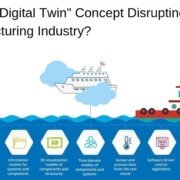How Is “Digital Twin” Concept Disrupting The Manufacturing Industry?

Previous waves of digital disruption have been characterized by replacing an existing product with a digital version that can be produced and distributed at a lower cost. For an example that shattered a long-established industry, look no further than the digitization of print media.
As digital disruption continues to transform more and more industries, one of the hot trends for 2018 is ‘digital twins’, with digital enhancing physical products and processes instead of completely replacing them.
The term ‘digital twin’ is widely credited to Dr. Michael Grieves, who used it in the 1980s while researching product lifecycle management at the University of Michigan. However, its true origins trace back to NASA’s work in pairing digital objects with physical ones in the early days of space exploration. At the time, this was achieved solely through simulation and modeling and did not benefit from communication between pairs of physical and digital objects.
Today, a digital twin is a near-real-time digital representation of a physical product, process or system. Internet of Things (IoT) sensors ensures changes in the physical system are immediately reflected in the digital twin, which is carefully analyzed to improve the performance of the actual product.
Read more
What is digital twin?
• This term was first introduced and clearly defined by Dr. Michael Grieves in 2003 at the University of Michigan.
• In digital twin, twin refers to the virtual representation/image (generally 3-D model) of a product, process or service. It’s a very important concept in the Internet of things (IoT).
How it works?
• Before the introduction of this concept, manufacturing companies used to create a virtual model of a new product (e.g. Car, bike, etc) first using computer-aided design (CAD) tools followed by converting this virtual model into an actual physical object. Then, they just discard or archive the virtual object as it was no longer in active use.
• With the digital twin concept, this virtual model is no longer discarded, rather, it is connected to the physical object through a cloud-based system. Also, a physical object does not use the same components as before in its development, rather, it contains smart components equipped with sensors.
• These sensors connected to the physical object collect real-time data about status, working condition, or position being integrated with a physical item, etc and send it back to the digital twin. Their interaction can help optimize the product’s performance.
For example, sensors might detect when a car’s engine oil needs changing, and the car’s digital twin will have an overlay image indicating the new information, which can appear on the owner’s smartphone or the manufacturer’s PLM system.
Need and Applications of Digital twin concept:
• This digital twin system can be leveraged to apply analytics for detecting anomalies, early warnings of glitches, predictions such as when to change engine filter, etc and optimization.
• For example, GE company has created Digital twin anomaly detection models to identify the anomalies in the bearings of rotating machines up to 60 days in advance, as opposed to usual 20–30 days.
Source: Ankit Sharma




